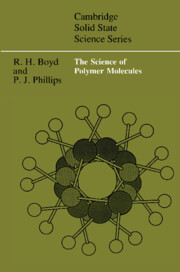Book contents
- Frontmatter
- Contents
- Preface
- 1 Polymerization: an overview
- 2 Molecular weight and molecular weight distribution
- 3 Molecular weight determination
- 4 Polymerization: kinetics and mechanism
- 5 Three dimensional architecture: conformation and stereochemical configuration
- 6 The statistical behavior of conformationally disordered chains
- 7 The interacting bond model for the average properties of coiling chains
- 8 Rubber elasticity
- 9 Solutions
- References
- Index
1 - Polymerization: an overview
Published online by Cambridge University Press: 29 October 2009
- Frontmatter
- Contents
- Preface
- 1 Polymerization: an overview
- 2 Molecular weight and molecular weight distribution
- 3 Molecular weight determination
- 4 Polymerization: kinetics and mechanism
- 5 Three dimensional architecture: conformation and stereochemical configuration
- 6 The statistical behavior of conformationally disordered chains
- 7 The interacting bond model for the average properties of coiling chains
- 8 Rubber elasticity
- 9 Solutions
- References
- Index
Summary
Polymers are large molecules made up of many atoms linked together by covalent bonds. They usually contain carbon and often other atoms such as hydrogen, oxygen, nitrogen, halogens and so forth. Thus they are typically molecules considered to be in the province of organic chemistry. Implicit in the definition of a polymer is the presumption that it was synthesized by linking together in some systematic way groups of simpler building block molecules or monomers. Although the final molecular topology need not be entirely linear, it is usually the case that the linking process results in linear segments or imparts a chain-like character to the polymer molecule.
Most of the synthetic methods for linking together the building block molecules can be placed into one of two general classifications. The first of these results when the starting monomers react in such a way that groups of them that have already joined can react with other already joined groups. The linked groups have almost the same reactivity towards further reaction and linking together as the original monomers. This general class of reactions is called step polymerization. In the other general method, an especially reactive center is created and that center can react only with the original monomer molecules. Upon reaction and incorporating a monomer, the reactive center is maintained and can keep reacting with monomers, linking them together, until some other process interferes.
- Type
- Chapter
- Information
- The Science of Polymer Molecules , pp. 1 - 17Publisher: Cambridge University PressPrint publication year: 1993

